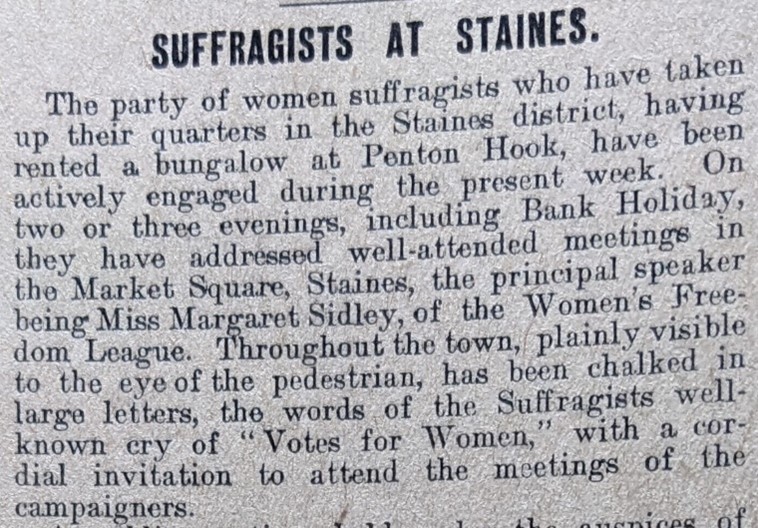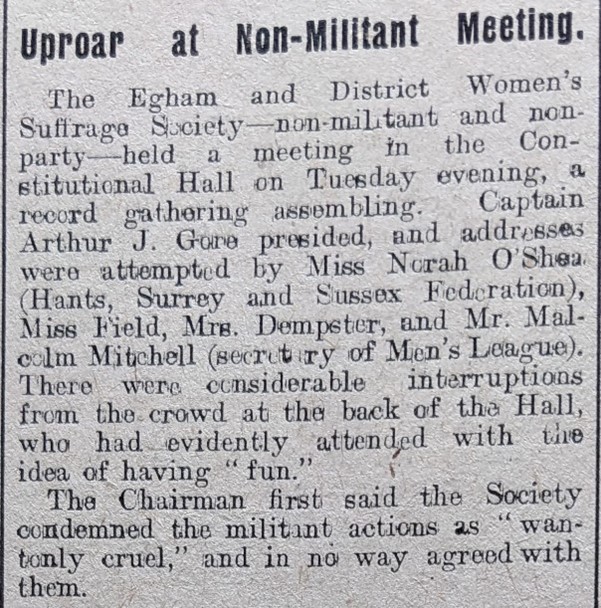Deeds and Words: Suffragettes and Suffragists
In May 2020, a portrait was discovered at Royal Holloway University that showed a woman in a black dress reading a book. For years people had believed this portrait to be of Emily Penrose, the Principal of Bedford College, and then Royal Holloway, between 1893 and 1907. However, the research of Dr Imogen Tedbury revealed that this portrait was actually of Millicent Fawcett – leader of the National Union of Women’s Suffrage Societies (NUWSS). The NUWSS was the largest society of Suffragists.
You may be wondering who the Suffragists were. The Suffragettes are better known today, these were men and women who fought for women’s right to vote by purposefully breaking the law to gain political attention. However, the Suffragists used only legal, ‘law-abiding’ methods and were found in local suffrage societies across Britain and Ireland. This map displays the British NUWSS branches, using data from Elizabeth Crawford’s The Women’s Suffrage Movement A Reference Guide 1866-1928.
Explore this map in ‘The Mystery of the Missing Suffragette’.
Using Egham Museum’s newspaper archive, we can uncover both Suffragette and Suffragist activity in Egham and the local area. These two groups are not as distinct as we might imagine, and these articles reveal that they were interwoven with each other.
‘Suffragists at Staines’

One article entitled ‘Suffragists at Staines’, published by The Surrey Herald on 4 June 1909, details how a group of Suffragists were speaking at ‘well-attended meetings in the Market Square’ in Staines. They had also written “Votes for Women” around Staines in chalk and had included ‘a cordial invitation to attend the meetings’.
Photo Credit: The Surrey Herald, 4 June 1909.
However, Suffragette speakers from the Women’s Social and Political Union (WSPU) found themselves speaking to ‘a sparely attended gathering’ instead. They held their meeting at Thames Street Hall, which the NUWSS had used the previous night. This meant that many people in Staines had assumed that the NUWSS and the WSPU were the same so did not feel the need to attend both meetings. This led to the WSPU speaker, Mrs Massey, having to explain that ‘there were several Suffragists’ Societies, but they were all working for the same object. She was a member of the militant section.’ It is important to note that Mrs Massey implies that she is part of the Suffragists, but in the militant wing. Here, the line between the Suffragettes and the Suffragists is blurred.
This article is also interesting as it demonstrates how at the time, there was a level of ‘misunderstanding’ within the public about the different branches and different methods used to campaign for women’s suffrage. This is understandable due to the plethora of groups fighting for women’s right to vote, from the WSPU, the NUWSS, the Central Committee of the National Society of Women’s Suffrage, the Women’s Franchise League, the Women’s Freedom League, the Men’s Political Union for Women’s Enfranchisement, the Men’s League for Women’s Suffrage, the Jewish League for Women’s Suffrage, the Cymric Suffrage Union, the Actresses Franchise League, to the United Suffragists. No wonder the people of Staines mistook the WSPU for the NUWSS! Another reason for the lack of attendance at the Suffragette meeting could have been a lack of support for the ‘militant’ side. Mrs Massey noted that ‘they were doing all those extraordinary things which people read in the papers and might think were unwomanly.’
‘Uproar at Non-Militant Meeting’
Just because the Suffragists were law-abiding, does not mean that they were not immensely passionate about the fight for women’s suffrage. In an article from 28 February 1913, The Surrey Herald documented an ‘Uproar at [a] Non-Militant Meeting’ in Egham. The Egham and District Women’s Suffrage Society, which is clarified for the reader as ‘non-militant and non-party’, experienced a dramatic meeting which was interrupted by a ‘crowd at the back of the Hall, who had evidently attended with the idea of having “fun”’.

A Suffragist called Miss O’Shea could not comprehend why women should not be given the vote when ‘very young men – such as had come to that meeting and did not know how to behave themselves’ were given the right to vote. The Surrey Herald noted that her remark was met with ‘laughter and applause’. There were later interruptions, arguing against the actions of the Suffragettes, and O’Shea noted that ‘those present were interrupting her because of their objections to what some women were doing to obtain the vote… it was unfair to condemn militancy if they would not listen to non-militant arguments’.
Photo Credit: The Surrey Herald, 28 February 1913.
Evidently, some ‘young men’ in Egham took their grievances about the Suffragettes out on the Suffragists. O’Shea did not condemn the actions of the Suffragettes, but instead argued that those men were not listening to either group. She implied that men like that ‘would be responsible for whatever was done’ by the Suffragettes, as they would not listen to anyone fighting for the right for women to vote. Miss Gardiner, another speaker, noted that they ‘owed a debt of gratitude to the militants for bringing the cause before the public, but they deplored the methods used.’ Interestingly, Gardiner saw ‘Mrs Pankhurst (the leader of the WSPU) [as] a heroine, and mentioned her with Joan of Arc’.
You can attend this Suffragist meeting in ‘The Mystery of the Missing Suffragette’.
These articles reveal that the divide between the Suffragettes and Suffragists was not black and white. In Staines, Mrs Massey saw the Suffragists as the larger body, and she was part of the ‘militant section’. In Egham, some Suffragists appreciated that the militant actions had brought more attention to the cause, whilst also holding the view that their actions were ‘deplorable’. Both Suffragettes and Suffragists were working towards a common goal and to keep them (and their histories) separate does not reflect the nuanced views that many men and women held at the time. For example, Mary Thompson was a student at Royal Holloway and had been a member of the NUWSS and then was arrested as a Suffragette, before later joining the United Suffragists and the Suffragette Fellowship.
Society today, and throughout history, has pitted women against each other. We have to actively push against this thinking when examining the history of those who fought for women’s suffrage.
But, who did fight for women’s suffrage? This next blogs explores Royal Holloway’s alumna who played a role in the fight for the vote.
Travel back to 1913 by playing the free online puzzle game ‘The Mystery of the Missing Suffragette’ to learn more about Suffragettes and Suffragists. Visit Royal Holloway and Egham, attend The Egham and District Women’s Suffrage Society meeting, and use your puzzle-solving skills to uncover the truth about “Mary Dean”. This game is suitable for ages 14 and over.
Further Reading:
‘Lost portrait of suffragist discovered at Royal Holloway’, Royal Holloway, https://www.royalholloway.ac.uk/about-us/news/lost-portrait-of-suffragist-discovered-at-royal-holloway/
‘Millicent Fawcett’, Suffrage Resources https://www.suffrageresources.org.uk/resource/3237/millicent-fawcett
‘Suffrage Societies Database Guide’, Suffrage Resources https://www.suffrageresources.org.uk/resource/3231/suffrage-societies-database-guide
‘100 Women: Suffragists or suffragettes – who won women the vote?’, BBC News, https://www.bbc.co.uk/news/world-42879161
‘Famous rallying speech by feminist leader Millicent Fawcett was never made says new book’, The Guardian, https://www.theguardian.com/world/2022/may/15/famous-rallying-speech-by-feminist-leader-millicent-fawcett-was-never-made-says-new-book
